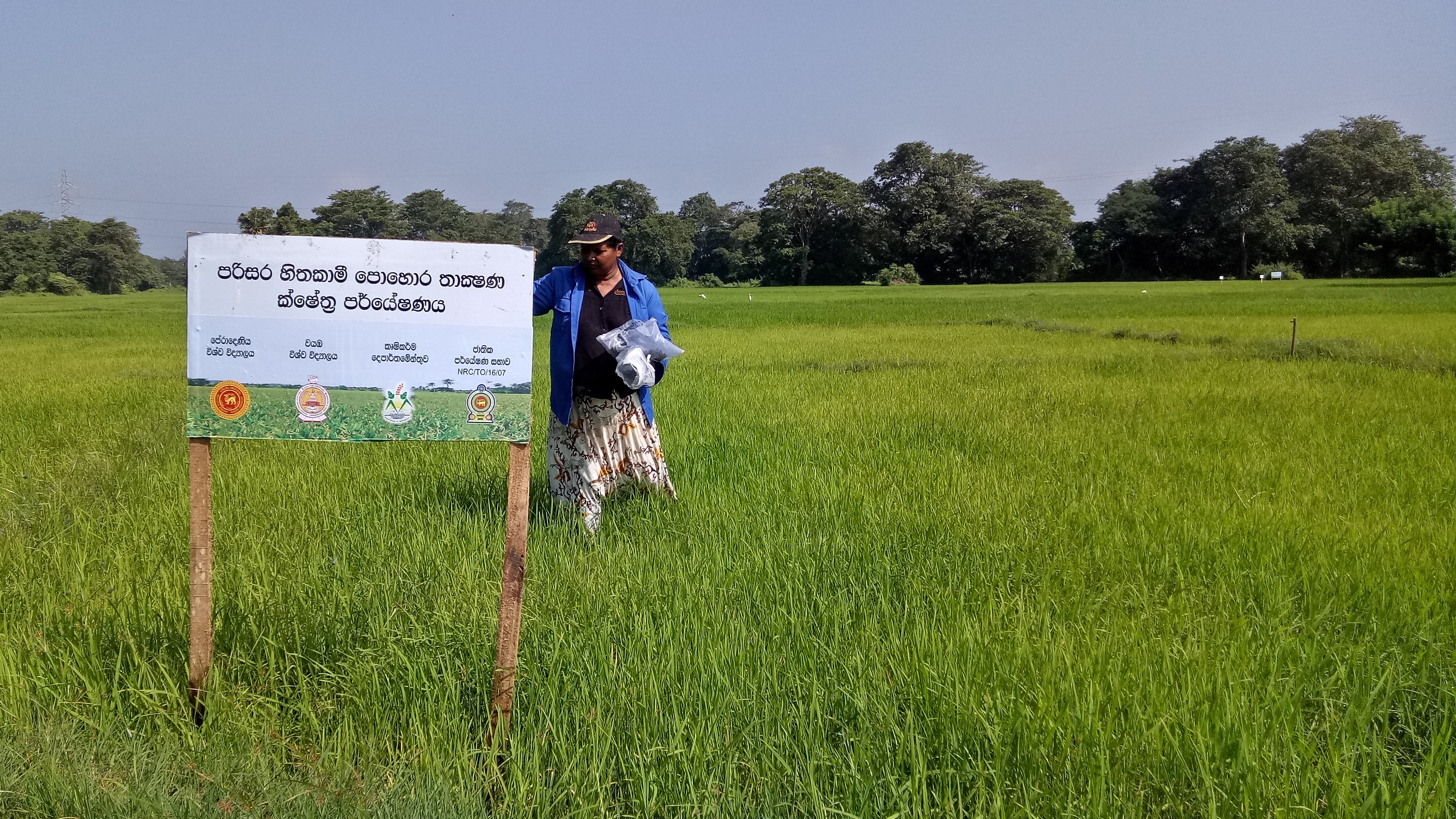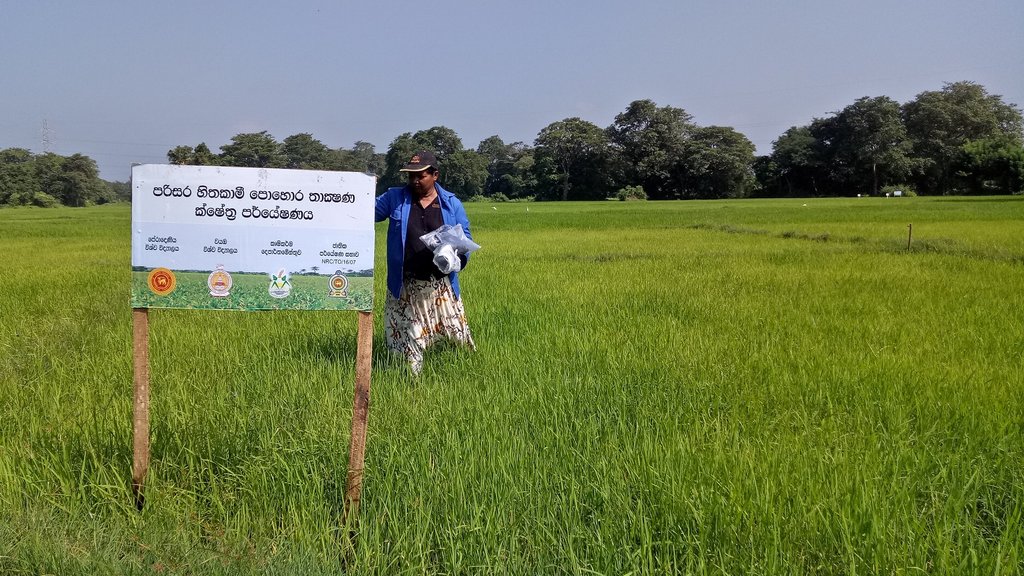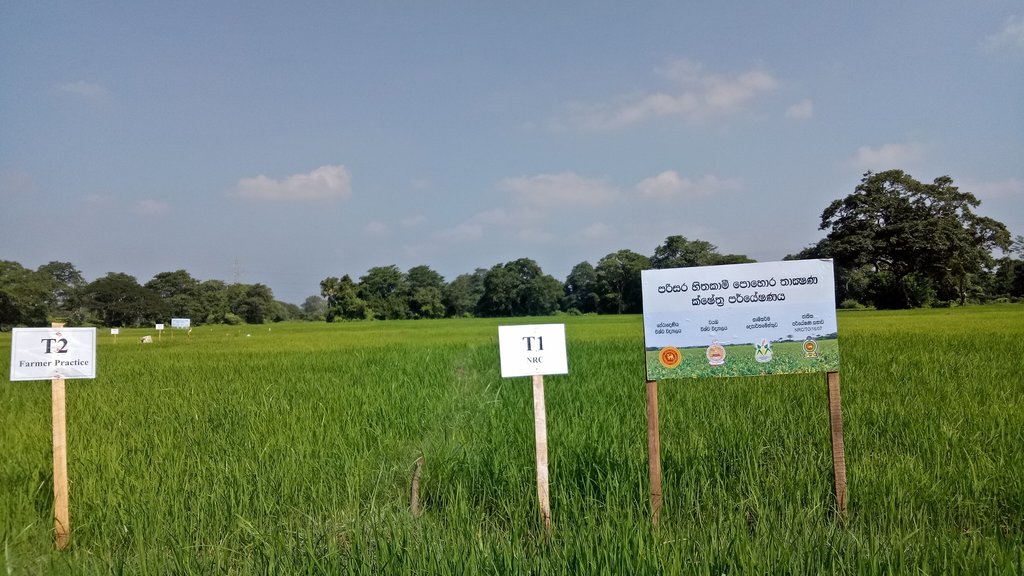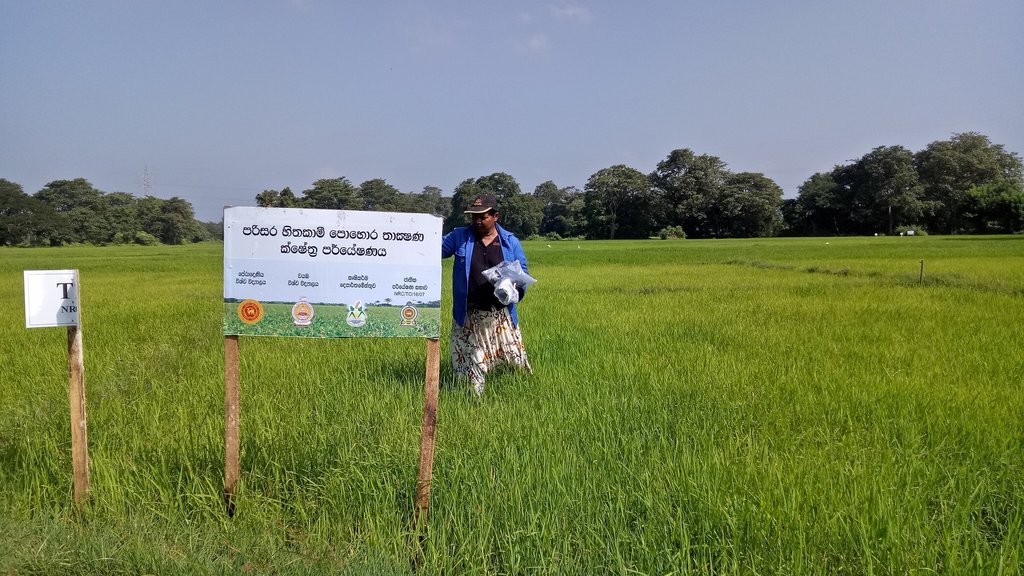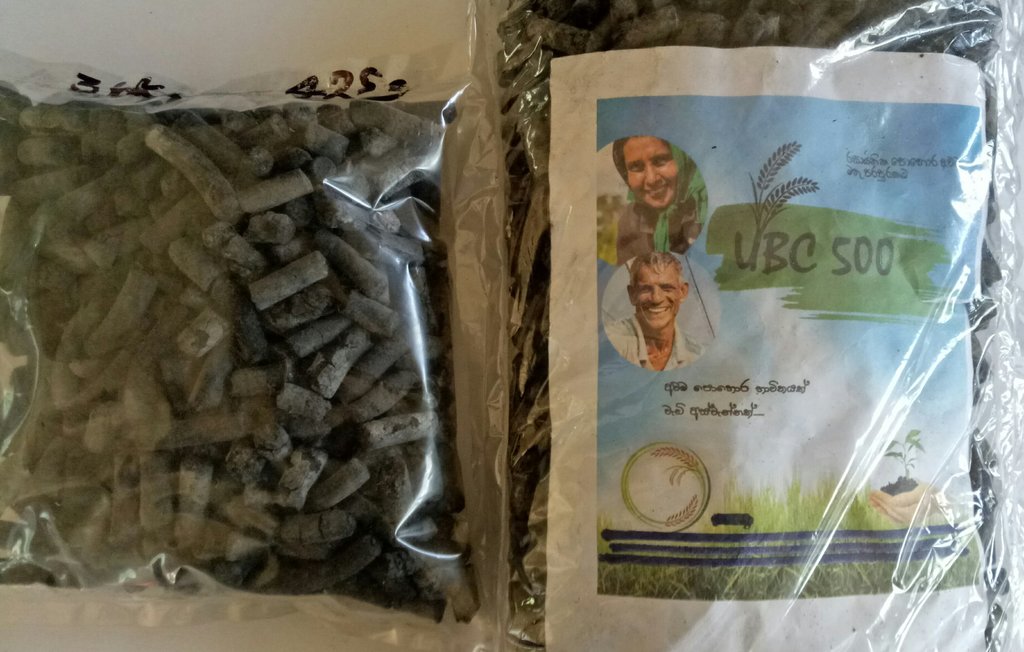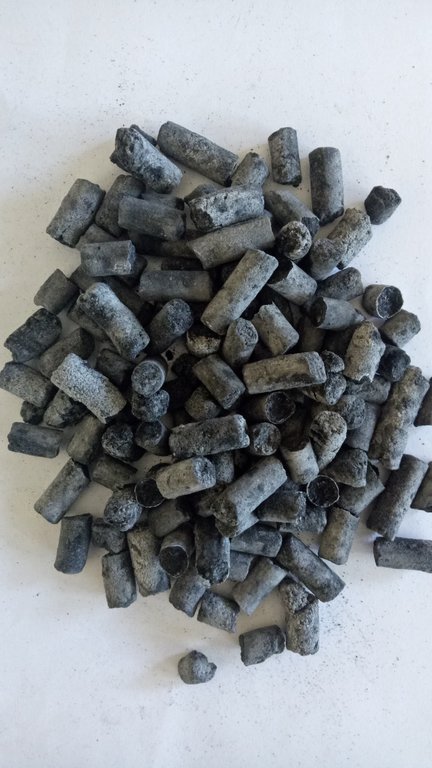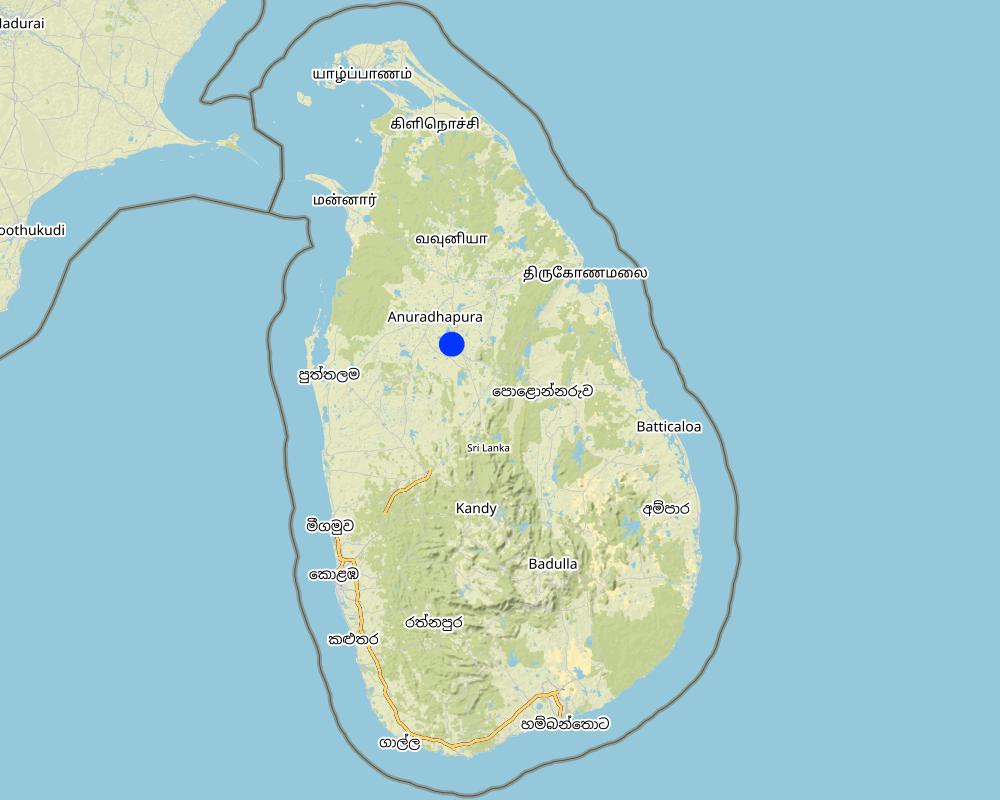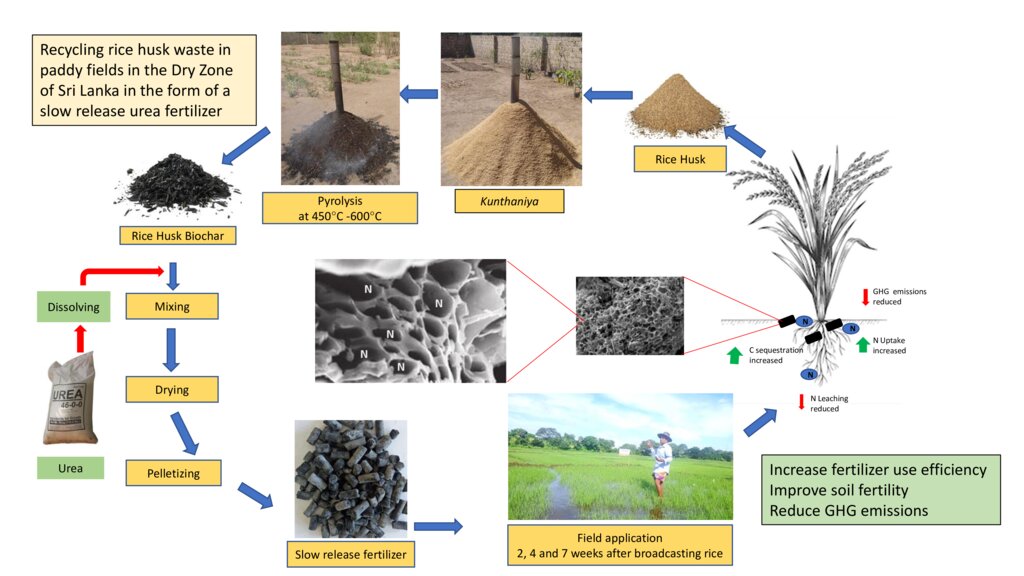Recycling rice husks in Sri Lanka as a biochar-based slow-release urea fertilizer [Sri Lanka]
- Criação:
- Atualização:
- Compilador/a: Head Soil Science
- Editor: –
- Revisores: William Critchley, Rima Mekdaschi Studer
“anguru kata” pohora
technologies_6184 - Sri Lanka
Veja as seções
Expandir tudo Recolher tudo1. Informação geral
1.2 Detalhes do contato das pessoas capacitadas e instituições envolvidas na avaliação e documentação da tecnologia
Pessoa(s) capacitada(s)
Especialista em GST:
Dissanayaka Lakmini
Coconut Research Institute
Sri Lanka
usuário de terra:
Senarathna Renuka
Sri Lanka
usuário de terra:
Nandasena Lekam Ralalage
Sri Lanka
usuário de terra:
Kirihamige Vimalawathi
Sri Lanka
co-compilador/a:
Dharmakeerthi Saman
University of Peradeniya
Sri Lanka
co-compilador/a:
Nome da(s) instituição(ões) que facilitou(ram) a documentação/ avaliação da Tecnologia (se relevante)
Faculty of Agriculture, University of Peradeniya, Sri Lanka (AGRI.PDN) - Sri Lanka1.3 Condições em relação ao uso da informação documentada através de WOCAT
O/a compilador/a e a(s) pessoa(s) capacitada(s) aceitam as condições relativas ao uso de dados documentados através da WOCAT:
Sim
1.4 Declaração de sustentabilidade da tecnologia descrita
A tecnologia descrita aqui é problemática em relação a degradação da terra de forma que não pode ser declarada uma tecnologia de gestão sustentável de terra?
Não
Comentários:
Urea is the type of nitrogen fertilizer available in Sri Lanka. Urea is readily soluble in water and hydrolyses to ammonia which in turn is converted to nitrate by microorganisms. Nitrate can be lost by leaching, volatilization, and denitrification in paddy fields. However, slow release fertilizer (SRF) releases the N in urea slowly to the soil and allows efficient uptake by the crop at the right time. Hence, it reduces the negative environmental impacts associated with N losses and also maintains adequate productivity in rice cultivation. In addition, this technology reduces CO2 emissions from rice husks to the atmosphere.
2. Descrição da tecnologia de GST
2.1 Descrição curta da tecnologia
Definição da tecnologia:
Rice husks, a waste product generated in rice mills, can release its carbon as a greenhouse gas (GHG) to the atmosphere through burning or decomposition. Converting it into biochar and intercalating (filled) with urea can produce a slow-release nitrogen (N) fertiliser that improves N-use efficiency while minimizing GHG emissions.
2.2 Descrição detalhada da tecnologia
Descrição:
Rice husks are often considered as a waste, and its carbon is released to the atmosphere as carbon dioxide (CO2) which is a greenhouse gas (GHG) through either decomposition or burning as a biofuel. However, rice husks can be converted into biochar – where its carbon is stable - with a large number of micro and sub-micron size pores in a honeycomb-like structure. Rice husk biochar was produced using an improved batch pyrolizer, “Kunthaniya”, at a temperature of between 450°C and 650°C. Pore spaces in rice husk biochar can be intercalated (filled) with urea and then, slow-release fertilizer (SRF) pellets can be produced through the use of a suitable biodegradable binder. This SRF has found to be more efficient in improving the N-use efficiency, hence the urea requirement of paddy fields in Sri Lanka can be reduced by about 25%, further contributing to environment sustainability. It has been well documented that biochar can improve soil physical, chemical and biological properties in a sustainable manner. This process is a contribution to creative recycling of agricultural waste.
The SRF technology was evaluated against current farmer practice in rice cultivated area in Mahakanumulla village, Anuradhapura district, Sri Lanka. The area belongs to the Dry Zone of Sri Lanka (mean annual rainfall <1750mm). Rice is cultivated during two seasons, yala (May-September) and maha (December – February): the yala season is generally drier. Farmers rely on irrigation water supplied from a small village tank. The SRF was transported to farmers’ fields and applied at 2 weeks (@ 100 kg/ha), at 4 weeks (@ 170 kg/ha) and 7 weeks (@ 145 kg/ha) after direct seeding.
Farmers indicated that the granule size was large and light, hence they had some concerns about even distribution of fertilizer. They perceive that plants receive N slowly compared to granular urea - suggesting the slow releasing nature of the new technology. They did not observe any yield difference. Obtaining rice husks in large quantities from rice mills to produce biochar can sometimes be difficult in some areas of the country due to competition for use in the poultry industry. Some farmers may be discouraged to implement this technology due to lack of knowledge: this can be overcome through extension officers operating at field level.
This new technology qualifies as a sustainable land management practice in number of ways. First it increases N-use efficiency in paddy fields, second it reduces the urea requirement by 25% while sustaining productivity, third it recycles agricultural wastes in paddy fields, fourth, repeated application of SRF improves soil fertility through rice husk biochar, and finally it reduces GHG emissions.
2.3 Fotos da tecnologia
Observações gerais sobre as fotos:
The photos show the application of SRF on farmers fields and the physical nature of the SRF.
2.5 País/região/locais onde a tecnologia foi aplicada e que estão cobertos nesta avaliação
País:
Sri Lanka
Região/Estado/Província:
North Central Province
Especificação adicional de localização:
Mahakanumulla village, Thirappane
Especifique a difusão da tecnologia:
- Aplicado em pontos específicos/concentrado numa pequena área
O(s) local(is) tecnológico(s) está(ão) localizado(s) em uma área permanentemente protegida?
Não
Map
×2.6 Data da implementação
Indique o ano de implementação:
2021
2.7 Introdução da tecnologia
Especifique como a tecnologia foi introduzida:
- durante experiências/ pesquisa
- através de projetos/intervenções externas
3. Classificação da tecnologia de GST
3.1 Principal/principais finalidade(s) da tecnologia
- Melhora a produção
- Reduz, previne, recupera a degradação do solo
- Atenuar a mudanças climáticas e seus impactos
- Criar impacto econômico benéfico
- Cria impacto social benéfico
3.2 Tipo(s) atualizado(s) de uso da terra onde a tecnologia foi aplicada
Uso do solo misturado dentro da mesma unidade de terra:
Não

Terra de cultivo
- Cultura anual
Cultivo anual - Especificar culturas:
- cereais - arroz (zona húmida)
Sistema de cultivo anual:
Arroz de zona úmida contínua
Número de estações de cultivo por ano:
- 2
Especifique:
yala and maha seasons
O cultivo entre culturas é praticado?
Não
O rodízio de culturas é praticado?
Não
3.3 O uso do solo mudou devido à implementação da Tecnologia?
O uso do solo mudou devido à implementação da Tecnologia?
- Não (Continuar com a pergunta 3.4)
3.4 Abastecimento de água
Abastecimento de água para a terra na qual a tecnologia é aplicada:
- Misto de precipitação natural-irrigado
Comentários:
Rice farmers in Mahakanumulla mainly depend on irrigation water supplied from a small tank located above the rice fields. However, farmers do not irrigate rice fields if they receive adequate rainfall. But, increasingly, farmers depend on irrigation water due to decreasing rainfall during the growing season.
3.5 Grupo de GST ao qual pertence a tecnologia
- Gestão integrada de fertilidade do solo
- Gestão de resíduos/gestão de águas residuais
3.6 Medidas de GST contendo a tecnologia

Medidas agronômicas
- A2: Matéria orgânica/fertilidade do solo
- A3: Tratamento da superfície do solo
- A6: Gerenciamento de resíduos
A3: Diferenciar os sistemas de lavoura:
A 3.3: Full tillage (< 30% soil cover)
A6: Especificar o gerenciamento de resíduos:
A 6.4: retido
Comentários:
Application of SRF to the crop at the required growth stages to improve the soil fertility and, thus, crop productivity.
3.7 Principais tipos de degradação da terra abordados pela tecnologia

Deteriorização química do solo
- Cn: declínio de fertilidade e teor reduzido de matéria orgânica (não causado pela erosão)
- Cp: poluição do solo

Degradação da água
- Hp: declínio da qualidade de água de superfície
- Hq: declínio da qualidade do lençol freático
Comentários:
The SRF technology improves soil fertility by reducing nitrogen (N) loss from the soil due to leaching. And it also reduces accumulation of excess N in surface and ground water bodies, preventing water pollution.
3.8 Redução, prevenção ou recuperação da degradação do solo
Especifique o objetivo da tecnologia em relação a degradação da terra:
- Reduzir a degradação do solo
Comentários:
The use of conventional N fertilizers to cultivate rice for a long period of time causes higher N losses from the soil and results a potential risk of environment pollution. Application as an SRF reduces the losses of N from the soil, increases crop nutrient uptake and increases crop productivity. The reduced losses mitigate soil fertility degradation and deterioration of water quality.
4. Especificações técnicas, implementação de atividades, entradas e custos
4.1 Desenho técnico da tecnologia
Especificações técnicas (relacionada ao desenho técnico):
Production of SRF: Rice husks were pyrolyzed using a locally modified “Kunthaniya” (a batch pyrolyser) to produce rice husk biochar. The temperature of the pyrolyser was around 450°C to 600°C with a heating rate of less than 20°C per hour. Pore structures were saturated using a urea solution through capillary action. The urea-intercalated rice husk biochar is then mixed with a biodegradable organic substance and pelletized using a medium scale pelletizer and dried to increase its mechanical properties such as resistance to disintegration and shear forces.
Field Experiment : Five paddy farmers were randomly selected from the command area of a small tank in the Mahakanumulla Village Tank Cascade System in the Dry Zone of Sri Lanka. The produced SRF was applied at a rate of 75% of recommended N in three split applications. Yields in SRF applied areas were compared against the current farmer practice. Experimental evidence showed that there is no yield reduction despite the reduction of nitrogen input into their fields.
Autor:
H.P.G.T.N. Kulasinghe
4.2 Informação geral em relação ao cálculo de entradas e custos
Especifique como custos e entradas foram calculados:
- por área de tecnologia
Indique o tamanho e a unidade de área:
1ha
Outro/moeda nacional (especifique):
LKR
Se for relevante, indique a taxa de câmbio do USD para moeda local (por exemplo, 1 USD = 79,9 Real): 1 USD =:
275,0
Indique a média salarial da mão-de-obra contratada por dia:
1500
4.3 Atividades de implantação
| Atividade | Periodicidade (estação do ano) | |
|---|---|---|
| 1. | Collection of paddy husk from rice milling stations | 2 months before cultivation |
| 2. | Pyrolyzing of paddy husk using a pyrolizer or a kunthani | 6 weeks before cultivation |
| 3. | Mixing with urea, ERP and other ingredients and pelletizing | 4 weeks before cultivation |
| 4. | Drying the pellets (SRF) | 2 weeks before cultivation |
| 5. | Packing and transporting SRF to the rice fields | 1 week before cultivation |
Comentários:
One of the major raw materials to produce SRF is rice husks and it can be supplied from rice milling stations, generally available year-round. However, there is competition for rice husks in the market because of demand from the poultry industry. Hence, finding rice husks is sometimes difficult in some areas of the country.
4.4 Custos e entradas necessárias para a implantação
| Especifique a entrada | Unidade | Quantidade | Custos por unidade | Custos totais por entrada | % dos custos arcados pelos usuários da terra | |
|---|---|---|---|---|---|---|
| Mão-de-obra | Manufacturing SRF | Labour days | 2,5 | 1500,0 | 3750,0 | |
| Fertilizantes e biocidas | Urea | kg | 200,0 | 270,0 | 54000,0 | |
| Material de construção | Binding materials 1 | kg | 10,0 | 25,0 | 250,0 | |
| Material de construção | Binding materials 2 | kg | 10,0 | 250,0 | 2500,0 | |
| Material de construção | Rice husk biochar | kg | 200,0 | 50,0 | 10000,0 | |
| Custos totais para a implantação da tecnologia | 70500,0 | |||||
| Custos totais para o estabelecimento da Tecnologia em USD | 256,36 | |||||
Se o usuário da terra arca com menos que 100% dos custos, indique quem cobre os custos remanescentes:
Project funded by the National Research Council of Sri Lanka (Grant No. : NRC TO-16/07)
Comentários:
SRF was given to the farmer, free, for application. The cost of SRF was borne by the project funded by the National Research Council of Sri Lanka (Grant No. : NRC TO-16/07)
4.5 Atividades recorrentes/manutenção
| Atividade | Periodicidade/frequência | |
|---|---|---|
| 1. | Application of first dose of SRF | 2 weeks after direct seeding of rice |
| 2. | Application of second dose of SRF | 4 weeks after direct seeding of rice |
| 3. | Application of third dose of SRF | 7 weeks after direct seeding of rice |
Comentários:
Application of correct amount of SRF at the correct growth stage of the rice crop is important for efficient uptake of N to the crop and reduce losses.
4.6 Custos e entradas necessárias pata a manutenção/atividades recorrentes (por ano)
| Especifique a entrada | Unidade | Quantidade | Custos por unidade | Custos totais por entrada | % dos custos arcados pelos usuários da terra | |
|---|---|---|---|---|---|---|
| Mão-de-obra | Labour for SRF application | Labour days | 3,0 | 1500,0 | 4500,0 | 100,0 |
| Custos totais para a manutenção da tecnologia | 4500,0 | |||||
| Custos totais de manutenção da Tecnologia em USD | 16,36 | |||||
4.7 Fatores mais importantes que afetam os custos
Descreva os fatores mais determinantes que afetam os custos:
Labour availability and finding raw materials are the major factors that affect the cost.
5. Ambiente natural e humano
5.1 Clima
Precipitação pluviométrica anual
- <250 mm
- 251-500 mm
- 501-750 mm
- 751-1.000 mm
- 1.001-1.500 mm
- 1.501-2.000 mm
- 2.001-3.000 mm
- 3.001-4.000 mm
- > 4.000 mm
Especifique a média pluviométrica anual em mm (se conhecida):
1400,00
Especificações/comentários sobre a pluviosidade:
The Mahakanumulla area receives monsoon rainfall during two distinct seasons, namely yala (May – September) and maha (December – February), hence a bimodal rainfall pattern can be observed. The highest amount of rainfall is received during the maha season, in which most of the rainfall comes from the North-eastern monsoonal rains. Lesser rainfall is received from the South-west monsoonal rains, during the yala season. Hence prolonged dry periods are observed during the yala season. Other than that, this area receives rainfall from two inter-monsoonal rains (March-April and October-November).
Indique o nome da estação meteorológica de referência considerada:
Mahailuppallama, Anuradhapura
Zona agroclimática
- Semiárido
Recorded minimum and maximum temperatures in the area are 20.8°C and 29.5°C respectively
5.2 Topografia
Declividade média:
- Plano (0-2%)
- Suave ondulado (3-5%)
- Ondulado (6-10%)
- Moderadamente ondulado (11-15%)
- Forte ondulado (16-30%)
- Montanhoso (31-60%)
- Escarpado (>60%)
Formas de relevo:
- Planalto/planície
- Cumes
- Encosta de serra
- Encosta de morro
- Sopés
- Fundos de vale
Zona de altitude:
- 0-100 m s.n.m.
- 101-500 m s.n.m.
- 501-1.000 m s.n.m.
- 1.001-1.500 m s.n.m.
- 1.501-2.000 m s.n.m.
- 2.001-2.500 m s.n.m.
- 2.501-3.000 m s.n.m.
- 3.001-4.000 m s.n.m.
- > 4.000 m s.n.m.
Indique se a tecnologia é aplicada especificamente em:
- Não relevante
Comentários e outras especificações sobre a topografia:
The altitude of the area is 112m. An undulating pattern of topography is a distinct feature of this landscape. The rice is cultivated mainly in the valley area of the catena and other upland crops are cultivated in the crest area of the catena.
5.3 Solos
Profundidade do solo em média:
- Muito raso (0-20 cm)
- Raso (21-50 cm)
- Moderadamente profundo (51-80 cm)
- Profundo (81-120 cm)
- Muito profundo (>120 cm)
Textura do solo (solo superficial):
- Grosso/fino (arenoso)
Textura do solo (>20 cm abaixo da superfície):
- Médio (limoso, siltoso)
Matéria orgânica do solo superficial:
- Médio (1-3%)
Caso disponível anexe a descrição completa do solo ou especifique as informações disponíveis, p. ex. tipo de solo, PH/acidez do solo, nitrogênio, capacidade de troca catiônica, salinidade, etc.
Rice growing soils of the Mahakanumulla area are classified as Alfisols (Typic endoaquaalf). The soil is poorly drained. The pH of the soil is in the neutral range (6.05-7.23). Soil EC (55.5-143.0 µs/cm, 1:2.5 soil:water) values did not show any occurrence of soil salinity. Av. P content of the soil (Olsen P) was low for rice growth (<5 mg/kg) and ranged from 2.9-3.5 mg/kg. Av. K content of the soils was medium to high for rice growth and ranged from 61.3-99 mg/kg.
5.4 Disponibilidade e qualidade de água
Lençol freático:
< 5 m
Disponibilidade de água de superfície:
Bom
Qualidade da água (não tratada):
apenas para uso agrícola (irrigação)
A qualidade da água refere-se a:
tanto de águas subterrâneas quanto de superfície
A salinidade da água é um problema?
Não
Ocorre inundação da área?
Não
Comentários e outras especificações sobre a qualidade e a quantidade da água:
The amount of water supplied through the irrigation is limited during the dry season (yala). The water quality is affected by soil macro-nutrients (N, P, K) added as fertilizers to the soil. Due to the undulating topography of the landscape, those soil nutrients can wash-off from higher positions to lower positions due to surface runoff and leaching into the ground water and accumulating in the water bodies in the lower positions of the catena.
5.5 Biodiversidade
Diversidade de espécies:
- Médio
Diversidade de habitat:
- Médio
Comentários e outras especificações sobre biodiversidade:
Number of different tree species, wild animals, birds, insects and aquatic life can be observed around Mahakanumulla village. Forest patches can be identified mostly around the small tank, and those areas are habitats for multiple wild animals and birds.
5.6 Características dos usuários da terra que utilizam a tecnologia
Sedentário ou nômade:
- Sedentário
Orientação de mercado do sistema de produção:
- misto (subsistência/comercial)
Rendimento não agrícola:
- 10-50% de toda renda
Nível relativo de riqueza:
- Pobre
Indivíduos ou grupos:
- Indivíduo/unidade familiar
Nível de mecanização:
- Trabalho manual
- Mecanizado/motorizado
Gênero:
- Mulheres
- Homens
Idade dos usuários da terra:
- meia-idade
Indique outras características relevantes dos usuários da terra:
Most of the land users are dependent on full time rice farming. But some land users use rice farming as a secondary source of income and do other jobs in the city. Most of the younger generation in the village are migrating for jobs in the cities.
5.7 Área média de terrenos utilizados pelos usuários de terrenos que aplicam a Tecnologia
- < 0,5 ha
- 0,5-1 ha
- 1-2 ha
- 2-5 ha
- 5-15 ha
- 15-50 ha
- 50-100 ha
- 100-500 ha
- 500-1.000 ha
- 1.000-10.000 ha
- > 10.000 ha
É considerado pequena, média ou grande escala (referente ao contexto local)?
- Pequena escala
Comentários:
Rice is cultivated over a large area. However, single farmer manage relatively small fields (0.5-1 ha or 2-5 ha). The fields managed by farmers are located adjacent to each other.
5.8 Propriedade de terra, direitos de uso da terra e de uso da água
Propriedade da terra:
- Indivíduo, intitulado
Direitos do uso da terra:
- Indivíduo
Direitos do uso da água:
- Comunitário (organizado)
Os direitos de uso da terra são baseados em um sistema jurídico tradicional?
Não
5.9 Acesso a serviços e infraestrutura
Saúde:
- Pobre
- Moderado
- Bom
Educação:
- Pobre
- Moderado
- Bom
Assistência técnica:
- Pobre
- Moderado
- Bom
Emprego (p. ex. não agrícola):
- Pobre
- Moderado
- Bom
Mercados:
- Pobre
- Moderado
- Bom
Energia:
- Pobre
- Moderado
- Bom
Vias e transporte:
- Pobre
- Moderado
- Bom
Água potável e saneamento:
- Pobre
- Moderado
- Bom
Serviços financeiros:
- Pobre
- Moderado
- Bom
Comentários:
The villagers of Mahaknumulla have access for most of the resources like infrastructure and energy/electricity/fuel. But most of the villagers/landusers complain about technical assistant/support for agricultural practices, finding markets for their produce and availability of good quality drinking water. The villagers go to nearby shops to buy day-to-day needs, but they have to go to the town, which is 8-10km away, for other services such as health and financial services.
6. Impactos e declarações finais
6.1 Impactos no local mostrados pela tecnologia
Impactos socioeconômicos
Produção
Produção agrícola
Quantidade anterior à GST:
6.5 t/ha (two seasons)
Quantidade posterior à GST:
6.9 t/ha (two seasons)
Comentários/especificar:
Although farmers could not observe a yield increase , experimental evidence suggests upto10% yield increase compared to farmer fertilizer management. A decrease in yield however not observed by farmers despite 25% reduction in N input. The above figures are for average of five farmers over two seasons.
Qualidade da safra
Risco de falha de produção
Diversidade de produtos
Área de produção
Gestão de terra
Disponibilidade e qualidade de água
Disponibilidade de água potável
Qualidade da água potável
Disponibilidade de água para criação de animais
Qualidade da água para criação de animais
Disponibilidade de água para irrigação
Qualidade da água para irrigação
Demanda por água para irrigação
Renda e custos
Despesas com insumos agrícolas
Quantidade anterior à GST:
LKR 60,750.00/ha for urea
Quantidade posterior à GST:
LKR 70,500/ha for SRF
Comentários/especificar:
LKR 270/kg urea and LKR 167/kg of SRF. Expenses were calculated assuming all other costs are constants under two situations
Rendimento agrícola
Quantidade anterior à GST:
LKR 520,000/ha
Quantidade posterior à GST:
LKR 552,000/ha
Comentários/especificar:
LKR 80/kg of paddy. Average yields mentioned above was used to calculate the farm income. Therefore, farm income is expected to be increased more than the expenses in SRF applied fields.
Diversidade de fontes de rendimento
Disparidades econômicas
Carga de trabalho
Comentários/especificar:
Although a longer time is required for SRF application because of higher bulk volume (175kg more), this application cost is negligible
Impactos socioculturais
Segurança alimentar/auto-suficiência
Comentários/especificar:
Expected improvements in productivity due to SRF application could strengthen the food security
Estado de saúde
Direitos do uso da terra/à água
Oportunidades culturais
Oportunidades de lazer
Instituições comunitárias
Instituições nacionais
Conhecimento de GST/ degradação da terra
Comentários/especificar:
Farmers gain awareness through extension programmes when implementing the SRF technology
Atenuação de conflitos
Situação de grupos social e economicamente desfavorecidos
Impactos ecológicos
Ciclo hídrico/escoamento
Quantidade de água
Qualidade de água
Comentários/especificar:
N accumulation in water bodies is reducing due to lower N losses of SRF
Colheita/recolhimento de água
Escoamento superficial
Drenagem de excesso de água
Lençol freático/aquífero
Evaporação
Solo
Umidade do solo
Comentários/especificar:
It is expected to have a better moisture content as a result of accumulation of biochar with repeated application of SRF
Cobertura do solo
Comentários/especificar:
Experimental evidence suggests that soil cover is more with rice plants that grow better and tiller more due to better N utilization for crop growth
Perda de solo
Acumulação de solo
Ressecamento/ selagem do solo
Compactação do solo
Ciclo e recarga de nutrientes
Quantidade anterior à GST:
N uptake: 167 kg of N/ha
Quantidade posterior à GST:
N uptake: 219 kg of N/ha
Comentários/especificar:
Higher uptake of N by rice plants due to SRF application, nutrient recycling is expected to be improved. The above values were obtained from 5 farmer fields in the year 2021.
Salinidade
Quantidade anterior à GST:
Electrical Conductivity : 0.11 dS/m
Quantidade posterior à GST:
Electrical Conductivity : 0.09 dS/m
Comentários/especificar:
The above values were obtained from 5 farmer fields in the year 2021.
Matéria orgânica do solo/carbono abaixo do solo
Comentários/especificar:
SRF contains biochar which is a good source to improve the soil C.
Acidez
Quantidade anterior à GST:
pH : 7.42
Quantidade posterior à GST:
pH : 7.38
Comentários/especificar:
The above values were obtained from 5 farmer fields in the year 2021.
Biodiversidade: vegetação, animais
Cobertura vegetal
Comentários/especificar:
Efficient uptake of N cause to improve the crop growth, thereby vegetation cover
Biomassa/carbono acima do solo
Quantidade anterior à GST:
5.2 t/ha (straw) + 8.1 (grain)
Quantidade posterior à GST:
6.0 t/ha (straw) + 8.7 t/ha (grain)
Comentários/especificar:
Higher crop growth results higher biomass production. The above values were obtained from 5 farmer fields in the year 2021.
Diversidade vegetal
Espécies exóticas invasoras
Diversidade animal
Espécies benéficas
Diversidade de habitat
Controle de praga/doença
Clima e redução de riscos de desastre
Impactos da inundação
Deslizamentos de terra/fluxos de escombros
Impactos da seca
Impactos de ciclones, temporais
Emissão de carbono e gases de efeito estufa
Risco de incêndio
Velocidade do vento
Microclima
Comentários/especificar:
Because of the better growth of the rice plants micro climate in the paddy fields is expected to be improved.
Especificar a avaliação dos impactos no local (medidas):
Plant growth parameters and yield
6.2 Impactos externos mostrados pela tecnologia
Disponibilidade de água
Caudal confiável e estável em período seco
Cheias de jusante
Sedimentação a jusante
Poluição de água subterrânea/rio
Comentários/especificar:
N accumulation in water bodies is expected to be reduced due to lower N losses from SRF
Capacidade de tamponamento/filtragem
Sedimentos transportados pelo vento
Danos em áreas vizinhas
Danos na infraestrutura pública/privada
Impacto dos gases de efeito estufa
6.3 Exposição e sensibilidade da tecnologia às mudanças climáticas graduais e extremos/desastres relacionados ao clima (conforme o ponto de vista dos usuários da terra)
Mudança climática gradual
Mudança climática gradual
| Estação do ano | aumento ou diminuição | Como a tecnologia lida com isso? | |
|---|---|---|---|
| Temperatura anual | aumento | não conhecido | |
| Precipitação pluviométrica anual | redução/diminuição | não conhecido |
6.4 Análise do custo-benefício
Como os benefícios se comparam aos custos de implantação (do ponto de vista dos usuários da terra)?
Retornos a curto prazo:
neutro/balanceado
Retornos a longo prazo:
levemente positivo
Como os benefícios se comparam aos custos recorrentes/de manutenção(do ponto de vista dos usuários da terra)?
Retornos a curto prazo:
positivo
Retornos a longo prazo:
levemente positivo
6.5 Adoção da tecnologia
- casos isolados/experimental
Se disponível, determine a quantidade (número de unidades familiares e/ou área abordada):
5 farmers/households
6.6 Adaptação
A tecnologia foi recentemente modificada para adaptar-se as condições variáveis?
Não
6.7 Pontos fortes/vantagens/oportunidades da tecnologia
| Pontos fortes/vantagens/oportunidades na visão do usuário da terra |
|---|
| This technology uses less chemical fertilizer and therefore it is good for their health and environment |
| This technology gives better crop growth and slightly higher yield |
| Biochar could improve the fertility of the soil |
| Pontos fortes/vantagens/oportunidades na visão do/a compilador/a ou de outra pessoa capacitada |
|---|
| SRF reduces the N losses from the soil and allows the rice crop to uptake N effectively from soil at required growth stages. Efficient N uptake promotes the crop growth and increase the productivity. |
| Reduced N losses of SRF directly influence the water quality by reducing the losses of N through surface runoff and leaching and avoid accumulation in water bodies at the lower positions of the landscape. |
| Rice husks, which is are good source of C, are utilized for SRF production; hence it promotes C sequestration as it is added back to the soil as biochar. It improves the soil organic carbon pool and promotes carbon sequestration in soil. |
| Utilizing rice husks by returning back to the rice fields is an effective solution for rice waste management. |
| If the SRF production technology can be transferred to farmers, their societies can produce the SRF by themselves from the wastes generated in small scale rice mills. |
6.8 Pontos fracos, desvantagens/riscos da tecnologia e formas de superá-los
| Pontos fracos/desvantagens/riscos na visão do usuário da terra | Como eles podem ser superados? |
|---|---|
| Additional cost despite reduced chemical fertilizer | increased crop yields can partially compensate this. They can produce their own SRF if the production technology is transferred to them |
| Uneven distribution of nitrogen in the field | Changing the water management practices that have been currently adopted by farmers |
| Pontos fracos/vantagens/riscos na visão do/a compilador/a ou de outra pessoa capacitada | Como eles podem ser superados? |
|---|---|
| The raw materials need to be formulated accurately to get the benefits of the technology. Hence, technical knowledge and experience is required when preparing SRF. | Proper guidance and technical support from the beginning to the end of the process is essential. This can be achieved through educating and training extension officers to teach and disseminate knowledge for farmers. |
7. Referências e links
7.1 Métodos/fontes de informação
- visitas de campo, pesquisas de campo
More than 10 field visits
- entrevistas com usuários de terras
Interviewed 5 farmers
Quando os dados foram compilados (no campo)?
08/05/2021
Comentários:
Plant growth measurements were collected 7 weeks after broadcasting rice and yield data collected after 3 ½ months after broadcasting.
7.2 Referências às publicações disponíveis
Título, autor, ano, ISBN:
Preparation of Biochar as a Soil Amendment from Rice Husk and Corn Cob by Slow Pyrolysis Process, S.T. Munasinghe, R.S. Dharmakeerthi, P. Weerasinghe and L.G.S. Madusanka, ISSN 0041-3224
Disponível de onde? Custos?
Tropical Agriculturist Journal
Título, autor, ano, ISBN:
Changes in Structural and Chemical Properties of Rice Husk Biochar Co-pyrolysed with Eppawala Rock Phosphate under Different Temperatures, D.K.R.P.L. Dissanayake, R.S. Dharmakeerthi, A.K. Karunarathna and W.S. Dandeniya, ISSN: 2706-0233
Disponível de onde? Custos?
Tropical Agricultural Research Journal
Título, autor, ano, ISBN:
Biochar Based Slow-Release Urea Fertilizer: Production and Assessing the Effects on Growth of Lowland Rice and Nitrogen Dynamics in an Alfisol, M.K.N.W. Jayarathna, R.S. Dharmakeerthi and W.M.U.K. Rathnayaka, ISSN: 2706-0233
Disponível de onde? Custos?
Tropical Agricultural Research Journal
7.3 Links para informações on-line relevantes
Título/ descrição:
Changes in Structural and Chemical Properties of Rice Husk Biochar Co-pyrolysed with Eppawala Rock Phosphate under Different Temperatures
URL:
http://192.248.43.153/bitstream/1/3160/2/PGIATAR_30_1_19.pdf
Título/ descrição:
Biochar Based Slow-Release Urea Fertilizer: Production and Assessing the Effects on Growth of Lowland Rice and Nitrogen Dynamics in an Alfisol
URL:
https://tar.sljol.info/articles/abstract/10.4038/tar.v32i2.8464/
7.4 Comentários gerais
The WOCAT questionnaire on SLM technologies covers all the aspects that can affect on the sustainability of natural and human environment.
Links e módulos
Expandir tudo Recolher tudoLinks
Não há links
Módulos
Não há módulos


